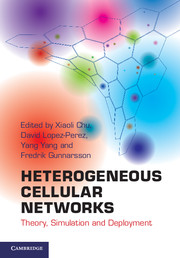Book contents
- Frontmatter
- Contents
- Acknowledgments
- Forewords
- Preface
- List of contributors
- Acronyms
- 1 Introduction
- 2 Radio propagation modeling
- 3 System-level simulation and evaluation models
- 4 Access mechanisms
- 5 Interference modeling and spectrum allocation in two-tier networks
- 6 Self-organization
- 7 Dynamic interference management
- 8 Uncoordinated femtocell deployments
- 9 Mobility and handover management
- 10 Cooperative relaying
- 11 Network MIMO techniques
- 12 Network coding
- 13 Cognitive radio
- 14 Energy-efficient architectures and techniques
- Intex
2 - Radio propagation modeling
Published online by Cambridge University Press: 05 June 2013
- Frontmatter
- Contents
- Acknowledgments
- Forewords
- Preface
- List of contributors
- Acronyms
- 1 Introduction
- 2 Radio propagation modeling
- 3 System-level simulation and evaluation models
- 4 Access mechanisms
- 5 Interference modeling and spectrum allocation in two-tier networks
- 6 Self-organization
- 7 Dynamic interference management
- 8 Uncoordinated femtocell deployments
- 9 Mobility and handover management
- 10 Cooperative relaying
- 11 Network MIMO techniques
- 12 Network coding
- 13 Cognitive radio
- 14 Energy-efficient architectures and techniques
- Intex
Summary
Introduction
In the past decade, radio wave propagation modeling has attracted a great deal of interest from both academia and industry, because it facilitates efficient computation of path loss between a transmitter and a receiver in a given scenario, and plays an important role in, e.g., radio link planning and optimization processes.
Radio waves are electromagnetic waves, which can be decomposed into electric and magnetic fields. Along the propagation direction, these two fields are perpendicular to each other, creating the effect of polarization. Radio propagation is affected by the environment. For example, radio waves diffract on the edges of objects, reflections occur on an object when the wavelength is much smaller than the dimension of the object, scattering occurs if the object surface is not smooth, and attenuation losses depend on the material and size of an object.
The radio spectrum is the most precious resource in wireless communications. Different frequencies are typically allocated for use in different systems. The frequency of a radio wave also has a great impact on its propagation. A higher frequency yields a smaller wavelength and vice versa. On the one hand, radio waves with a higher frequency generally experience a higher attenuation loss, and thus propagate a shorter distance before the carried signal strength falls below a threshold. On the other hand, radio waves with a lower frequency have a larger wavelength, and can bypass obstructions more easily. Moreover, radio waves at adjacent frequencies may interfere with each other, hence it is necessary to carefully allocate frequency bands to avoid significant interference between different communication systems or even between radio links within the same system.
- Type
- Chapter
- Information
- Heterogeneous Cellular NetworksTheory, Simulation and Deployment, pp. 15 - 56Publisher: Cambridge University PressPrint publication year: 2013
- 1
- Cited by



